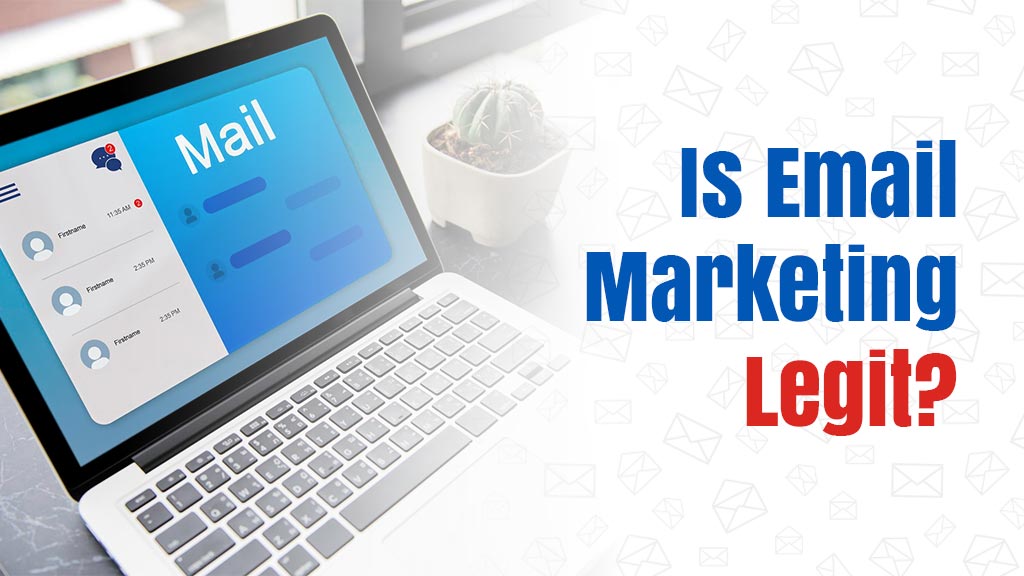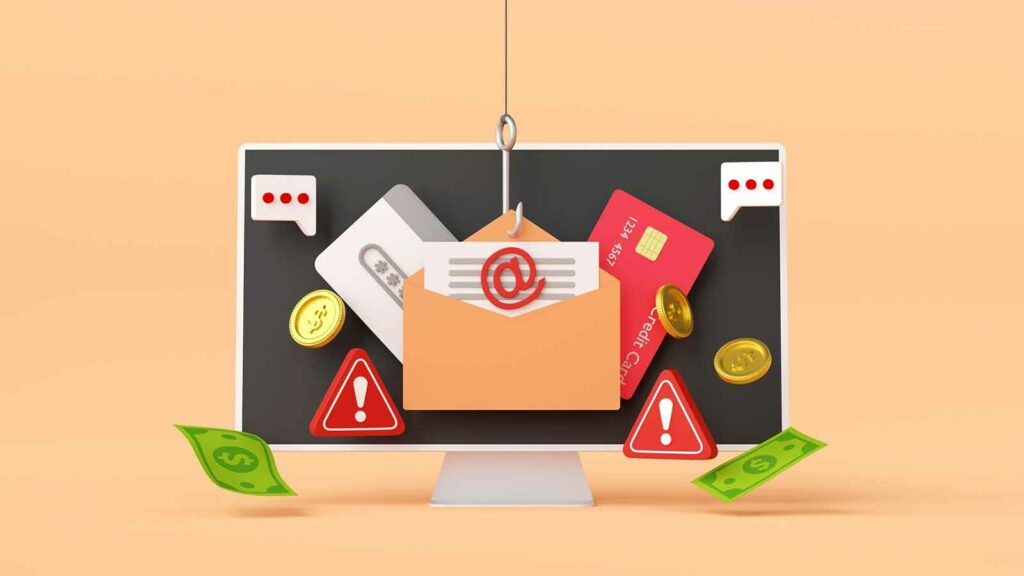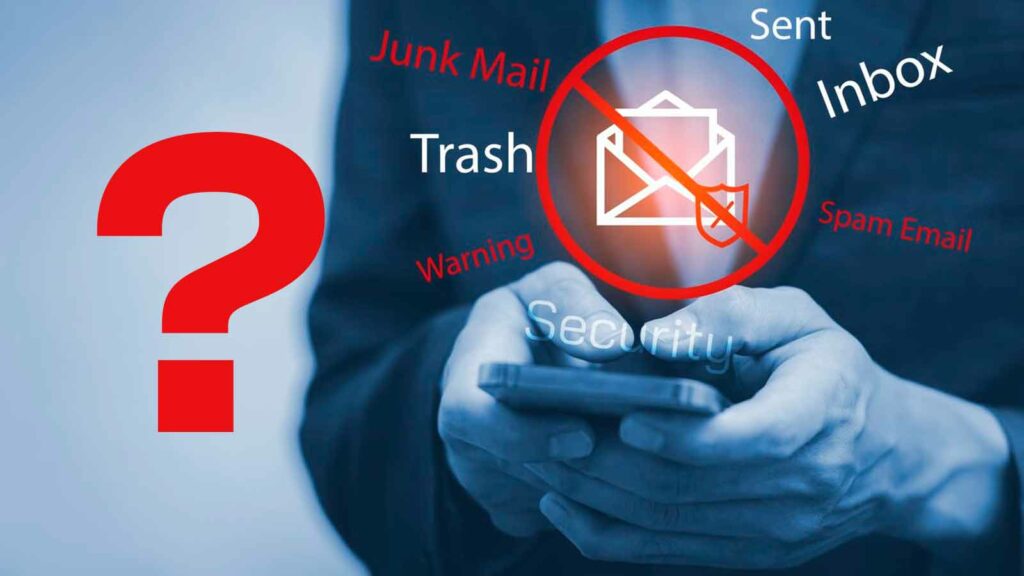
Is Email Marketing Legit? Is It A Spam Or Not?
There is a lot of marketing hype in the digital space, so people are naturally suspicious of some of the claims made. Particularly scrutinized has been email marketing. It begs the question: Is email marketing legitimate, or is it just a channel for spam?
Email marketing is a legitimate and widely accepted strategy for businesses to connect with their audience. While spam exists, ethical email marketing involves targeted, permission-based communication. Honest campaigns prioritize consent, offer opt-out options, and focus on delivering valuable content, fostering trust, and building positive relationships with subscribers.
This article will set out on a quest to clarify myths and prove that email marketing is real. Let’s explore email marketing to discover how it works in today’s ever-changing marketing world.
Is Email Marketing Legit?

Yes, email marketing is a legitimate and widely accepted digital marketing strategy. It involves sending targeted messages to a group of individuals via email to promote products, services, or engage with the audience. Legitimate email marketing campaigns adhere to ethical practices, obtaining consent from recipients and providing options to unsubscribe.
It is a cost-effective and efficient way for businesses to communicate with their audience, build brand awareness, and drive conversions. However, it is essential to distinguish between legitimate email marketing and scams, implementing security measures and ethical guidelines to protect the business and its subscribers.
Is Email Marketing Spam?

No, email marketing is not inherently spam. While spam refers to unsolicited and irrelevant messages sent in bulk, email marketing involves sending targeted, permission-based messages to individuals who have willingly subscribed or shown interest in a brand’s communication. Legitimate email marketing campaigns adhere to ethical practices, obtain consent, and allow recipients to unsubscribe.
On the other hand, spam lacks the necessary permission and often seeks to deceive or exploit recipients. Successful email marketing builds trust, delivers value, and fosters positive relationships, contributing to the overall success of businesses in reaching and engaging their audience.
How To Spot Email Marketing Scams?

In today’s digital age, email marketing is essential for businesses to connect with their audience. However, the rise of email scams threatens the integrity of marketing campaigns. To ensure the success of your email marketing efforts and protect your subscribers, it’s crucial to be vigilant and adopt effective strategies to spot and prevent scams. Here are some tricks to keep fraudsters out of your email marketing campaign.
Verify the Sender:
Verifying the sender of each email is a fundamental step in distinguishing legitimate communications from scams. Authentication through frameworks like Sender Policy Framework (SPF), DomainKeys Identified Mail (DKIM), and Conformance, Reporting, and Authentication of Messages in Domains (DMARC) helps establish your identity as a sender.
- SPF: SPF allows domain owners to specify which mail servers are authorized to send emails on behalf of their domain.
- DKIM: DKIM uses digital signatures to verify the authenticity of email headers. It involves encrypting email headers with a digital signature, which can be verified using a public cryptographic key stored in the sender’s DNS records.
- DMARC: DMARC builds on SPF and DKIM to provide additional authentication. It allows domain owners to specify policies for how email receivers should handle unauthenticated emails.
Implementing these authentication mechanisms, especially DKIM enhances your emails’ credibility and helps build trust with your audience.
Properly Request Personal Information:
While gathering personal information is a legitimate aspect of email marketing, it’s crucial to do it correctly to avoid being perceived as a scam. Phishing phrases and urgent language can raise suspicions among recipients. Instead, follow these guidelines:
Choose Words Carefully: Avoid using urgent language that may trigger suspicion. Craft your messages thoughtfully to convey critical information without creating a sense of urgency.
Give Each Message a Unique Touch: Personalize your emails by addressing recipients using their name or customer ID. This sets your communications apart from generic scam emails.
Ensure the “From” Name is Obvious: Identify yourself in the “from” name, enhancing transparency and trust. Scammers often use generic or misleading sender names.
Supply Helpful Content:
Distinguish your marketing emails from fraudulent messages by providing valuable content. While scammers often focus on promotional messages, offering information that genuinely benefits your audience establishes credibility and fosters a positive relationship. Abide by the marketing principle of providing value before making a sale.
Make Use of Proper Language:
Email scams are notorious for containing misspellings and grammatical errors. Ensure the professionalism of your content by hiring expert proofreaders or using premium grammar tools. A polished and error-free presentation instills confidence in your subscribers and sets you apart from fraudulent communications.
By incorporating these strategies into your email marketing practices, you can create a secure and trustworthy environment for your subscribers. Protecting your campaign from scams safeguards your brand’s reputation and nurtures long-lasting relationships with your audience.
Benefits Of Email Marketing

This affordability enables small businesses with limited budgets to use effective marketing strategies.
Client Base Growth:
Building and maintaining a loyal client base is crucial for the sustained success of any business. Email marketing facilitates the growth of your client base by connecting with potential customers and nurturing relationships with existing ones. Through targeted and personalized communication, companies can attract new clients and foster loyalty among current ones.
Brand Promotion:
Consistent and well-crafted email campaigns serve as a powerful tool for brand promotion. You reinforce brand awareness by directly conveying your brand’s message, values, and offerings to your audience’s inbox. Engaging content and visually appealing designs in your emails contribute to creating a positive and memorable brand image.
Increased Website Traffic:
Email marketing is a driving force to attract more visitors to your website. By strategically incorporating links to your website within your email content, you encourage recipients to explore your online platform further. This increased traffic enhances your online visibility and provides lead generation and conversion opportunities.
Boost in Sales:
Ultimately, the primary goal of any marketing effort is to drive sales. Email marketing proves to be an effective sales tool by nurturing leads and guiding potential customers through the purchasing journey. With strategic calls-to-action and personalized content, businesses can significantly influence their audience’s decision-making process, increasing sales and revenue.
Adjustable Strategies Based on Insights:
One of the unique advantages of email marketing is the ability to adapt strategies based on real-time insights and data. Analyzing open rates, click-through rates, and customer engagement allows businesses to refine their approaches. This data-driven approach ensures that marketing efforts are optimized for maximum impact and effectiveness.
Personalization for Enhanced Engagement:
Email marketing lets businesses personalize communication based on recipient preferences, behaviors, and demographics. Personalized emails create a sense of connection and relevance, leading to higher engagement rates. Companies can foster stronger relationships with their audience by tailoring content to individual interests and needs.
Measurable and Trackable Results:
Unlike traditional advertising methods that may be challenging to measure, email marketing provides transparent and trackable results. Through analytics tools, businesses can assess each campaign’s performance, identify improvement areas, and measure the return on investment (ROI). This data-driven approach empowers businesses to make informed decisions and optimize their marketing strategies.
Some Common Misconceptions About Email Marketing

Email marketing is a powerful and widely used tool for businesses, but it often falls victim to misconceptions that can hinder its effectiveness. Let’s unravel the truth behind five common misconceptions about email marketing.
1. Email Marketing is Outdated:
Some believe that email marketing has become obsolete with the rise of social media and other digital platforms. Contrary to this belief, email marketing remains a cornerstone of digital communication. With billions of active email users globally, it provides a direct and personalized channel for businesses to connect with their audience. Email marketing is evolving, incorporating automation, personalization, and dynamic content to stay relevant in the modern marketing landscape.
2. Email Marketing is Spam:
A prevalent misconception is equating email marketing with spam. While spam involves unsolicited, irrelevant, and often deceptive messages, legitimate email marketing focuses on delivering valuable content to a targeted audience. Ethical email marketers obtain consent from recipients and provide clear options to unsubscribe. Effective email marketing is permission-based, fostering trust and engagement rather than resorting to intrusive practices.
3. Emails Are Not Read:
There’s a belief that people rarely read their emails, leading to the assumption that email marketing messages go unnoticed. In reality, email remains a preferred communication channel for many, with a large percentage of users actively checking their inboxes. The key is to craft compelling subject lines, personalized content, and engaging visuals to capture recipients’ attention. A well-executed email marketing strategy can yield high open and click-through rates.
4. Quantity Over Quality:
Some mistakenly believe that success in email marketing is solely about sending a high volume of emails. Quantity, however, only sometimes translates to quality engagement. Overloading subscribers with frequent, irrelevant messages can lead to fatigue and increased unsubscribe rates. The focus should be on delivering valuable and targeted content that aligns with the interests and preferences of the audience. Quality over quantity ensures a positive recipient experience and fosters long-term engagement.
5. Email Marketing is Only for Sales:
A common misconception is viewing email marketing solely as a sales tool. While driving sales is a significant goal, email marketing serves a broader purpose. It is a versatile platform for building relationships, enhancing brand awareness, and providing valuable information to subscribers. Educational content, newsletters, and updates contribute to a well-rounded email marketing strategy, creating a connection with the audience beyond transactional interactions.
Tips For An Effective Email Marketing Strategy

Here are key tips to enhance your email campaigns and engage your audience:
Create an Email List:
Building a high-quality email list is the foundation of a successful email marketing campaign. Implement registration forms on your website or utilize pop-ups to capture email addresses from potential customers and subscribers. Ensure that your list comprises serious prospects, allowing you to convert leads into loyal customers.
Craft Attention-Grabbing Headlines:
The subject line is a critical component of an email’s clickbait factor. Create concise, detailed subject lines that captivate the reader’s attention. Avoid clichés and focus on compelling language to entice recipients to open your emails. A well-crafted headline sets the tone for the entire message.
Make Your Emails Mobile-Friendly:
Given the prevalence of mobile device usage, optimizing emails for mobile viewing is essential. Shorten subject lines, eliminate unnecessary content, use larger font sizes, incorporate thumbnail images, and provide a direct call-to-action. Ensuring your emails are easily readable on mobile devices enhances accessibility and engagement.
Avoid Spam Filters:
Protect your emails from being filtered into spam folders, which can significantly reduce open rates. Utilize spam checkers to identify potential issues before sending emails. Adhering to best practices and avoiding spam triggers increases the chances of your emails reaching the intended recipients.
Implement Segmentation:
Segmenting your audience based on shared characteristics enables you to tailor your content and maximize relevance. Personalization enhances engagement and prevents your emails from being perceived as generic or irrelevant. Embrace the uniqueness of your audience segments to create targeted consumer experiences.
Find the Sweet Spot for Sending:
Timing plays a crucial role in email marketing success. Research indicates that the optimal time for email to open is between 8 p.m. and midnight. Sending emails during this window increases the likelihood of recipients engaging with your content—experiment with sending times to determine the sweet spot that resonates with your audience.
Supply Helpful Content:
Deliver value through your emails by providing relevant and helpful content. Understanding your target audience’s needs and challenges allows you to create resonant material. Avoid generic or uninteresting content, as it diminishes the likelihood of engagement. Genuine and valuable content increases open rates, and fosters trust among recipients.
Finding the Right KPIs for Email Marketing

In email marketing, selecting the right Key Performance Indicators (KPIs) is vital for assessing campaign effectiveness. Here’s a concise guide on identifying and monitoring the most crucial KPIs:
1. Open Rates:
The first and foremost KPI to prioritize is the open rate. This metric reveals the percentage of emails successfully opened by the intended audience. Monitoring available rates provides insight into the initial engagement level of your recipients. A higher open rate indicates that your subject lines and email content resonate with your audience.
2. Click-Through Rates (CTR):
Equally important is the click-through rate (CTR), showcasing the number of recipients who actively engaged with your email’s Call-to-Action (CTA). A high CTR signifies that your content is compelling and prompts desired actions from your audience. By analyzing CTR, you can gauge the effectiveness of your email in driving meaningful interactions.
3. Continuous Monitoring and Adjustment:
Regularly monitor these KPIs and observe how they evolve as you adjust your email marketing strategy. Analyzing trends in open rates and CTR helps you understand what resonates with your audience. Make informed tweaks to your approach, incorporating more of the content and links your subscribers find engaging to witness continuous improvement.
4. Benchmark Against Industry Standards:
To set realistic goals and benchmarks for your email marketing performance, compare your open rates and CTR to industry standards. Understanding the average performance metrics in your sector provides context and helps you assess whether your campaigns are outperforming or lagging behind industry norms.
Is Email Marketing Still A Practical Approach In The Social Media Age?

Yes, email marketing remains an efficient approach in the social media age. Despite the dominance of social platforms, email marketing offers unique advantages. By bypassing algorithms and providing direct access to recipients’ inboxes, emails allow for more focused and individualized communication. Additionally, email marketing provides accurate monitoring and analytics, offering valuable insights into subscribers’ habits and preferences.
The ability to tailor content based on this data enhances engagement. Furthermore, integrating email marketing with social media creates a powerful, all-encompassing marketing strategy. By leveraging the strengths of both channels, businesses can maximize reach, engagement, and the overall effectiveness of their digital marketing efforts in the dynamic landscape of the social media age.
FAQs
Is Email Marketing Considered A Legitimate Form Of Communication?
Absolutely. Email marketing is a widely accepted and legitimate way for businesses to engage with their audience. It involves sending targeted, permission-based messages to individuals who have willingly subscribed or shown interest in a brand’s communication.
How Does Email Marketing Differ From Spam?
While spam involves unsolicited and irrelevant messages sent in bulk, legitimate email marketing is permission-based. It focuses on delivering valuable content to a targeted audience, obtaining consent from recipients, and providing clear options to unsubscribe.
Can Email Marketing Be Personalized For Different Audience Segments?
Yes, personalization is a key aspect of effective email marketing. Customizing email content based on the interests and requirements of specific target segments enhances relevance and engagement, fostering stronger connections with subscribers.
What Elements Contribute To The Effectiveness Of Email Content?
Attention-grabbing headlines, compelling images, and clear calls to action are essential for effective email content. These elements capture the recipient’s attention and prompt desired actions, contributing to the success of email marketing campaigns.
Is Experimenting With Timing And Design Crucial For Email Marketing Success?
Indeed, experimenting with alternative timing, designs, and text is essential to optimize email marketing success. Different audiences may respond better to emails at specific times or prefer particular visual styles, making experimentation valuable for identifying the most effective strategies.
How Can I Make Data-Driven Decisions To Improve Email Performance?
Regularly evaluating email performance through data-driven analysis allows you to identify areas for improvement. Analyzing open and click-through metrics provides insights into what resonates with your audience, enabling informed decision-making.
How Often Should I Evaluate The Performance Of My Email Marketing Campaigns?
Frequent evaluation is crucial. Regularly assessing email performance lets you stay informed about the effectiveness of your campaigns. This ongoing analysis enables you to adapt and refine your approach, ensuring your emails engage your audience and achieve your marketing goals.
Finally, How Can I Ensure The Effectiveness Of My Emails?
To ensure the effectiveness of your emails:
- Prioritize personalized, high-quality content tailored to specific target segments.
- Craft attention-grabbing headlines, compelling images, and clear calls to action.
- Experiment with alternative timing, designs, and text to optimize engagement.
- Regularly evaluate email performance through data-driven analysis to identify areas for improvement.
Consistent monitoring allows you to refine your approach, ensuring your emails resonate with your audience and achieve the desired impact. By staying attentive to content customization, visual appeal, and strategic experimentation, you can enhance the overall effectiveness of your email marketing campaigns.

















































